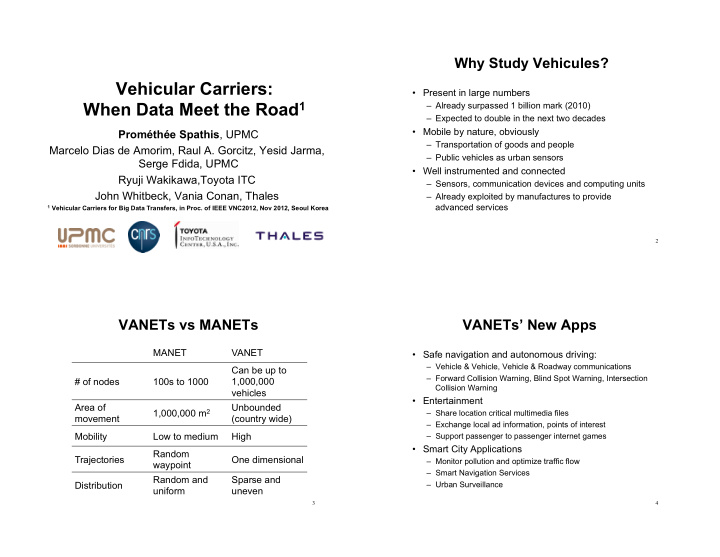



Why Study Vehicules? Vehicular Carriers: • Present in large numbers When Data Meet the Road 1 – Already surpassed 1 billion mark (2010) – Expected to double in the next two decades • Mobile by nature, obviously Prométhée Spathis , UPMC – Transportation of goods and people Marcelo Dias de Amorim, Raul A. Gorcitz, Yesid Jarma, – Public vehicles as urban sensors Serge Fdida, UPMC • Well instrumented and connected Ryuji Wakikawa,Toyota ITC – Sensors, communication devices and computing units John Whitbeck, Vania Conan, Thales – Already exploited by manufactures to provide advanced services 1 Vehicular Carriers for Big Data Transfers, in Proc. of IEEE VNC2012, Nov 2012, Seoul Korea 2 VANETs vs MANETs VANETs’ New Apps MANET VANET • Safe navigation and autonomous driving: – Vehicle & Vehicle, Vehicle & Roadway communications Can be up to – Forward Collision Warning, Blind Spot Warning, Intersection # of nodes 100s to 1000 1,000,000 Collision Warning vehicles • Entertainment Area of Unbounded 1,000,000 m 2 – Share location critical multimedia files movement (country wide) – Exchange local ad information, points of interest Mobility Low to medium High – Support passenger to passenger internet games • Smart City Applications Random Trajectories One dimensional – Monitor pollution and optimize traffic flow waypoint – Smart Navigation Services Random and Sparse and – Urban Surveillance Distribution uniform uneven 3 4
Research in VANETs The World of Big Data • MAC & Physical Layer – DSRC – IEEE 802.11p • Data Dissemination – More later • Mobility Models & Simulators – Traffic Simulators – Real Traces • Security & Privacy – False Data – DOS Attacks – Privacy 5 6 Data Management Vehicles as Data Carriers • Large companies, organizations, universities, Vehicular-based opportunistic bulk delay-tolerant and governmental agencies data transfers using offloading technique • Technical flexibility and cost-effective scalability • Balance workloads, fast data retrieval, data replication, resources consolidation • Cloud computing, multimedia transfers, data migration, disaster recovery, online backups, file/email archiving 7 8
Autonomy Predictable itinerary Mobile Modular Data Centers Room for storage capacity 9 10 Dataset • Annual Average Daily Traffic (AADT) • Provided by the French Ministry of Ecology, Energy, and Sustainable Development • Used for transportation planning and engineering • Measured from 2010 to 2011 • Multiple point of measurements per highways 11 12
Computing Transfer Latency Highway Capacity vs Vehicle Density 160 Total Data Distance 250GB 1TB Latency (hours) 120 s f × (( k × K ) − k 2 ) × S × P + d D × K Transfer τ = s · 80 Latency ¯ Measured value (5.96 Vehicles/Km) 40 Avg Speed Storage Vehicle Density 0 Capacity 0 10 20 30 40 50 60 70 Vehicle density (Vehicles/Km) Penetration Ratio 1 Pbytes data – Class A vehicles – 3-lane rural highway 13 14 Intercity scenario: Tours – Orléans Average Transfers Delay Lille Transfer latency for delivering up System throughput for delivering to 1 PB of data between Orleans up to 1 PB of data using the delay A = 52,390 and Tours using vehicle carriers. ! constraints obtained in Figure 1. ! 6.6 h τ = A = 32 , 935 9.2 h τ = 280 Paris 30 Vehicle Flow = 706 Veh/H 260 31,753 A = Le Mans A = 21,408 10.5 h τ = 25 240 Penetration Rate = 20% Orleans 12.2 h τ = Angers System throughput (Gbps) Dijon 220 Tours Highway Length = 118 Km 20 Latency (hours) 200 A = 46,290 53,196 A = 6.4 h Average Speed = 100 Km/H τ = 180 6.4 h τ = 15 33,922 Lyon A = 160 250GB 8.2 h τ = 250GB 1TB 140 Valence A = 64,535 10 1TB 4.7 h 120 τ = 100 5 Avignon A = 67,813 80 4.7 h τ = Α " Annual Average Daily Traffic 0 60 400000 700000 1e+06 400000 700000 1e+06 τ Average Transfer Latency Total data (GB) Total data (GB) 15 16
Impact of Speed and Distance Cost Comparison Cost comparison between a full Cost comparison between Internet electrical recharge cost and a with dedicated links and Vehicular 9 Latency (hours) package delivery system. ! Carriers. 1TB 6 Speed influence proportion 2000 60000 3 1800 50000 21.6% 19.1% 16.3% 15.6% 14.2% 13.1% 12.1% 11.2% 1600 0 40000 Internet (1TB) Cost (in Euros) Cost (in Euros) Internet (250GB) 60 70 80 90 100 110 120 130 Energy (1TB) 1400 Average vehicle speed (Km/h) Energy (250GB) 30000 1200 12 20000 1000 Latency (hours) 9 1TB 10000 800 Energy cost Distance influence proportion UPS cost 6 36.1% 600 0 33% 400000 700000 1e+06 29.7% 400000 700000 1e+06 26% 3 22% Total data (GB) 17.4% Total data (GB) 11.3% 6.5% 0 50 100 150 200 250 300 350 400 17 18 Distance on highway (Km) Conclusion Open Issues • Offloading delay tolerant data to vehicles • Routing could ease the burden on the legacy Internet • Delay sensitiveness infrastructure • Context • Resilience/robustness • Vehicular Carriers can be higly efficient in • Reliability terms of transfer latency when large amounts • Security of data are considered • Incentives • Business model • Incentive based motivational actions can increase the penetration ratio of the system 19 20
Recommend
More recommend